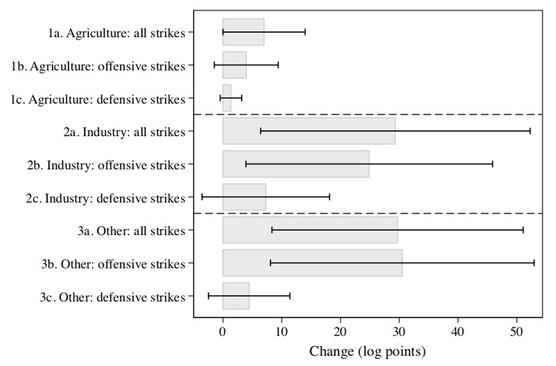The ongoing debate on how automation may change the labour market is ridden by anxiety. Most notably, a study has warned that 48% of the US workforce could be replaced by computers within a few decades (Frey and Osborne 2017). In addition, empirical evidence suggests that middle-class or medium-skilled workers are the most vulnerable to job loss (Goos and Manning 2007, David et al. 2006).
The disruptive effects of new technology beg the question how societies will react if stable middle-class jobs are taken over by machines. Some scholars argue that we already see the effects. Technological anxiety could be behind recent electoral outcomes, sometimes referred to as ‘protest voting’, in countries from Sweden to the US (Dal Bo et al. 2017, Frey et al. 2017).
History offers several examples of protests against technological development. The most well-known cases are the Luddite uprising and the Captain Swing Riots in Britain during the early 19th century. Recent research has established a causal link between the adoption of threshing machines and the frequency of local riots during the 1830s (Caprettini and Voth 2017).
But although it is easy to be caught by the dramatic and colourful stories of machine breaking, the question is how representative they have been in the overall spectrum of workers’ responses to technological change. It seems that the revolutionary new technologies related to motorisation and electrification appearing in the late 19th century (sometimes referred to as the Second Industrial Revolution) were not associated with riots against machines. In a recent book, Frey (2019) suggests that the absence of conflicts can be explained by the increasing supply of good jobs that were relatively easy to learn.
In a new study (Molinder et al. 2019), we analyse the impact of technological change on labour markets and social protests. More precisely, we study the adoption of electricity and how it influenced labour conflicts in the form of strikes in 2,487 parishes in early 20th century Sweden.
We gathered a dataset consisting of all recorded strikes during the period, geocoded at their location, allowing for a separation between offensive and defensive strikes. Among offensive claims are those relating to wage increases, while defensive claims often concern strikes against deteriorating working conditions or wage cuts (Enflo and Karlsson 2018).
The most commonly mentioned cause of strikes was wage claims, while the adoption of new technology was rarely mentioned as an explicit motivation for conflict. Naturally, technology can still be an underlying cause, since it influences both working conditions and wages. In addition, new technology may shift the balance of power between employers and workers and thereby influence workers’ propensity to strike.
Electrification as a local technology shock
To investigate the link between new technology and protests in the form of strikes, we use the local implementation of electricity as a shock to new technology. Gaining access to grid-powered electricity involved a more stable source of energy and increased the incentives to invest in motor-driven, potentially labour-saving, machinery. Sweden offers an illuminating example since its electrification was early and pervasive, and the country simultaneously experienced one of the industrial world’s highest incidence of strikes per capita.
Figure 1 depicts the expansion of the electricity grid from 1906, to 1911, through to 1916, based on digitised survey maps collected from the Swedish National Archive (Riksarkivet). The rapid expansion of the network is striking: in 1906, less than 5% of parishes were traversed by the grid; by 1916, the number had increased to more than 40%.
Figure 1 Rollout of the Swedish electricity grid, 1906–1916
A public company, The Royal Waterfall Board (Kungliga Vattenfallsstyrelsen), was set up to construct hydro-powered electric plants at large waterfalls. We exploit the fact that the locations for the state-run hydro plants were guided by the availability of very large waterfalls, as well as their strategic location in a network intended to cover the entire country. Hydro plants were not located in previously industrial regions since exploitable waterfalls were too large to make proper use of with the simpler water-turbines technology. Smaller waterfalls for industrial uses abound elsewhere in Sweden. Figure 1 shows the location of the three state-run hydropower plants – Olidan, Älvkarleby, and Porjus.
The impact on jobs and protests
In order to understand how electricity may influence protests, we first analyse the effects of electrification on local labour demand in jobs with different skill levels. Information on the occupational structure of each parish is based on full-count census data from the North Atlantic Population Project (NAPP) and have been coded according to the skill categories offered in HISCLASS.
Figure 2 suggests that electrification drove a relatively substantial shift in terms of occupational upgrading and sectoral specialisation. The largest employment increase is found among those jobs requiring medium skills. We do not see any sign that electricity was a skill-biased technology when looking at the highest skill groups (the elite, white-collar workers, and foremen). Neither do we find signs of ‘hollowing out’ at the other side of the tail, since the lower-skilled jobs were also disappearing.
Figure 2 Regression results for absolute growth of occupational groups
Notes: This figure shows coefficients and 95% confidence intervals for the impact of a parish gaining access to electricity on the growth of employment by skill group. Standard errors clustered at the parish level. The full regression tables can be found in Molinder et al. (2019).
The pattern in Figure 2 pertains to all sectors taken together. Previous studies establishing the role of electricity in driving the ‘hollowing out’ of the skill-distribution have focused on the manufacturing sector alone (Gray 2013). When taking the entire economy into consideration, the sectoral pattern strongly suggests upgrading and structural change. While there is a contraction of low-skilled jobs in agriculture, there is evidence of some low-skilled job growth in industry.
When analysing electrification’s impact on strikes, our results confirm that parishes that were electrifying were more likely to experience conflicts. But it was not the displaced workers in agriculture that were likely to protest. Instead, strikes were most common in sectors with employment growth. Similarly, we find that the strikes were predominantly of an offensive, rather than a defensive, nature. Figure 3 shows how the incidence of strikes increased in the industrial sector. In the agricultural sector, where most low-skilled jobs were disappearing, the effects on strikes were negligible.
Figure 3 Regression results for strikes by sector
Concluding remarks
Our results from the electrification example confirm that new technology increased the incidence of local strikes. However, the disputes were typically not of the intention to block the development. Instead, electrification was associated with workers demanding higher wages and better working conditions, rather than defending their status quo. This pattern could easily have escaped observation since workers did not explicitly relate their demands and actions to electrification.
Looking at the past two centuries, offensive worker responses to technological change may actually have been much more common than the machine-breaking protests of the early 19th century. Electrification as a historical example suggests that strikes may be influenced by technology changing workers’ relative bargaining position. Investments in new electrical machinery may have increased the costs of a temporal work stoppage and made strikes a more efficient conflict weapon.
Future research should pay closer attention to the role of unions as strategic interactors in the response to technological change.
References
Caprettini, B, and H-J Voth (2017), “Rage against the machines: Labour-saving technology and unrest in England, 1830-32”, CEPR Discussion Paper 11800.
Dal Bo, E, F Finan, O Folke, J Rickne and T Persson (2017), Economic losers and political winners: The rise of the radical right in Sweden, technical report, Uppsala University.
David, H, L F Katz and M S Kearney (2006), “The polarization of the US labor market”, American Economic Review 96(2): 189–94.
Enflo, K, and T Karlsson (2018), “From conflict to compromise: The importance of mediation in Swedish work stoppages 1907–1927”, European Review of Economic History hey023.
Frey, C B (2019), The technology trap: Capital, labor, and power in the age of automation, Princeton: Princeton University Press.
Frey, C B, T Berger and C Chen (2017), “Political machinery: Automation anxiety and the 2016 US presidential election”, technical report, Oxford Martin School Working Paper.
Frey, C B, and M A Osborne (2017), “The future of employment: How susceptible are jobs to computerisation?”, Technological Forecasting and Social Change 114:254–80.
Frey, C B, T Berger, C Chen (2018), “Political machinery: did robots swing the 2016 US presidential election?”, Oxford Review of Economic Policy 34(3): 418–42.
Goos, M, and A Manning (2007), “Lousy and lovely jobs: The rising polarization of work in Britain”, The Review of Economics and Statistics 89(1): 118–33.
Molinder, J, T Karlsson and K Enflo (2019), “More power to the people: Electricity adoption, technological change and social conflict”, CEPR Discussion Paper 13986.
Gray, R (2013), “Taking technology to task: The skill content of technological change in early twentieth century United States”, Explorations in Economic History 50(3): 351–67.









